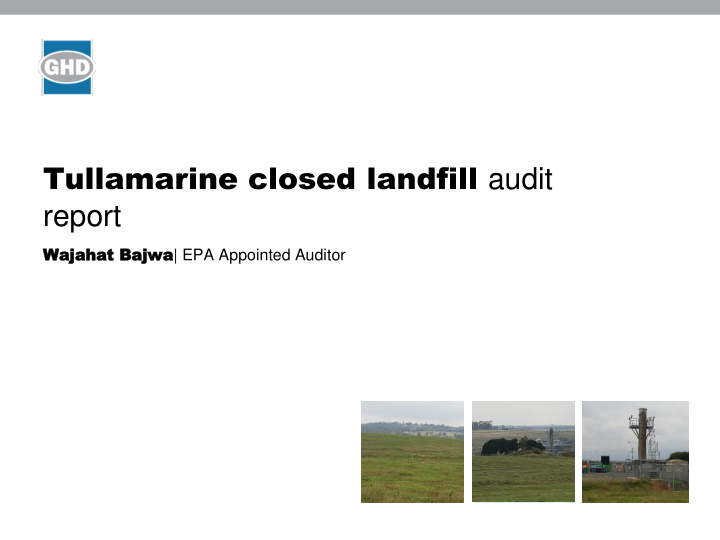



Tullamarine closed landfill audit report Wajah Wajahat B at Bajw ajwa | EPA Appointed Auditor Image Image Image placeholder placeholder placeholder
Audit report – overview and scope Independent EPA-appointed auditor appointed to prepare an audit as per EPA guidelines: • Identify and where possible, quantify the risk of any potential harm or detriment to the environment caused by operations and after care management • Review the completeness of the site risk assessment • Re-verify the landfill monitoring program • Assessed ongoing aftercare management, audit period was July 2017 – June 2018, historical data referenced where appropriate for context • Considered potential impact to beneficial uses relevant and existing for the site and surrounds in accordance with State environment protection policies • Revised risk assessment based on risk to beneficial uses and recommendations provided. Presentation title
Audit report – review of information • Audit report lists information supplied to the auditor for the audit (Table 3) • Auditor reviewed available monitoring data, completed site visits, looked at previous reports and used information to develop an understanding of the site conditions and management (summarized in site description, section 3). • Reviewed previous recommendations and their implementation (section 4), PC PAN requirements (Section 5) and the requirements of the monitoring program (Section 6) • Completed detailed assessment of monitoring data in the context of the surrounding environment and completed risk assessments related to leachate and groundwater (section 8), landfill gas (section 9) and other aspects and impacts (section 10). • Assessed the adequacy of the monitoring program and reviewed it and made recommendations for its improvement to address risks (section 11) Presentation title
Risk assessment – key findings Risk to groundwater beneficial uses: • Determined which beneficial uses apply based on the SEPP (Waters) • Determined if each beneficial use is likely to exist or be relevant at the site and surrounds • Assessed and assigned risk based on likelihood of impact (i.e., pathway for impact and beneficial use existing and relevant) and available monitoring data and previous reports • The auditor has reviewed previous risk assessments and reviews by auditors and attempted to assess if risks remained the same based on more recent data compared with historical data and reports, noting that there are gaps in the monitoring data • All risks assigned as low except for Primary Contact Recreation, this assignment of a medium risk is based on the (low) possibility of contact with groundwater extracted for filling pools and contact with creek water. Assignment of medium partly based on uncertainty due to monitoring gaps. Presentation title
Risk assessment – key findings Risk associated with landfill gas: • Assessed risks as ‘low’ except for direct emissions to open air, assigned medium because there was not follow up on exceedances on triggers from penetrations through the cap – risk may be low, upon showing follow up and rectification and consistently compliant results. • Medium risk for subsurface migration (accumulation in buildings and structures and services), buildings onsite and nearby service pits – offsite buildings nearby to west only. • Recommendations made in regards to monitoring to assess risks and to update monitoring program so all required monitoring is captured and completed. Presentation title
Risk assessment – key findings Risk assessment ‘other key aspects and impacts’: Risks assigned as low for potential pathways of impact (sub-surface migration of volatiles into enclosed spaces; leachate discharge to waters/inadequate containment, above ground leachate discharges, contaminated stormwater discharges With regards to sub-surface migration of volatiles into enclosed spaces – the review of the Groundwater Quality Management Plan and Liquid Waste Management Plan in 2012 (by EPA auditor, Anthony Lane) notes long-term risk to the environment is low, with the exception to land to the south-east. An audit on the land to the south east in 2015 concluded risk to this land via this pathway is low. Notes that current dataset is limited to assess petroleum and chlorinated hydrocarbons and has recommended updating risk assessment to confirm low vapour intrusion. Presentation title
Monitoring program - identified non- conformances • Non conformances were predominantly related to gaps in the required monitoring program (missing data). • Where monitoring data was not available for the audit period the auditor looked at overall data record, technical reports and audit documents (by other auditors) and professional judgement and experience to assign risk ratings • Table 7 in the audit report – details the monitoring requirements and where the gaps are, such as not meeting the monitoring frequency for LNAPL thickness and levels and missed groundwater monitoring locations • Sections 8, 9 and 10 refer to the available monitoring and other information to assess risks. Where data gaps cause too much uncertainty based on professional experience – a higher risk is assigned. Presentation title
Conclusions Audit report includes 59 recommendations, assigned high, medium or low priority: • Additional monitoring for leachate, groundwater and landfill gas • Revision of monitoring program and inclusion of trigger levels • Update of the Hydrogeological Assessment for auditor verification • Ongoing audits at an annual frequency for at least two years to assess implementation of recommendations Presentation title
www.ghd.com Presentation title
Recommend
More recommend